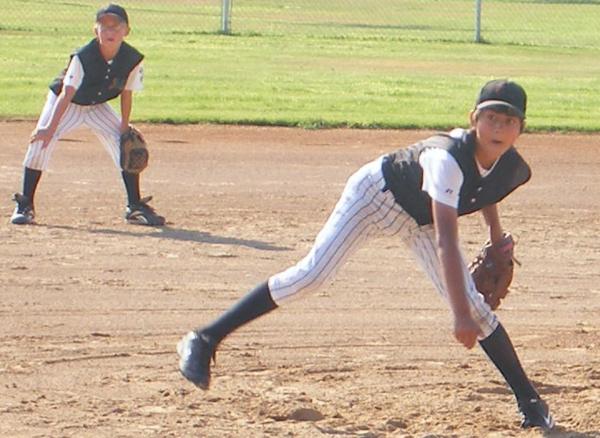Stretching exercises maintain good shoulder flexibility and reduce the risk of rotator cuff and other shoulder injuries to baseball pitchers and other throwing athletes (football quarterbacks, javelin throwers). Without a stretching program, athletes tend to develop muscle imbalances over the course of a season. Some muscles become too tight, others too weak. Stronger muscles end up overpowering good mechanics, exposing the athlete to increased risk of a shoulder injury. A balanced and flexible shoulder are thus critically important to maximizing performance and minimizing the risk of injury.

The following five stretching exercises are ones that throwing athletes should perform every other day to help ensure good muscle balance in the shoulder that helps the athlete maintain good pitching and throwing mechanics:
Doorway Stretch (shoulder at 45, 90, and 135 degrees)
A tight pectoralis minor (the small muscle located in the chest that connects to the scapula in the front) has a tendency to tilt the shoulder forward, increasing the risk of rotator cuff impingement while throwing. Shoulders that are rounded forward are an indication of a tight pectoralis minor.
Instructions:
- Place arms/shoulders at 45 degree at sides, hands against each side of the doorway.
- Lean forward with a slightly flexed back and tight abs.
- Hold for 20-30 seconds. You should feel the stretch in the front of the shoulder and into the chest.
The pectoralis major (large muscle located in the chest) is the one of two very important muscles for throwing harder. Very strong and tight chest muscles can round the shoulders forward and make reaching back to throw a ball more difficult and increases the risk of rotator cuff impingement. The lack of flexibility reduces ball velocity and control due to a shortened throwing motion.
Instructions:
- Same as previous stretch except arms are at 90 degrees to the floor (essentially bending elbows to 90 degrees, shoulders parallel to the floor)
- Lean forward with tight abs, slightly flexed back (same as previous exercise.
The latissimus dorsi ("lats") is another large muscle located in the back that is very important for throwing harder. Tight lats cause the shoulder to improperly balance during the throwing motion. Also, because the muscles connect to the spine, tight lats will reduce the ability to maintain core stability during throwing by causing the back to hyperextend.
Instructions:
- Same as previous stretch except arms are at 135 degrees to the floor (arms out straight, making a giant "Y").
- Tight abs, slightly flexed back (same as before).
Back/Front of the Shoulder
Posterior Cuff : The back of the shoulder has tendency to tighten in throwing athletes because the fast motion of throwing forces the shoulder to "slide forward" with every toss. This causes the back of the shoulder to tighten over time. A tight posterior cuff can increase strain on the front of the shoulder and increase risk for rotator cuff problems.
Instructions:
- Squeeze shoulder blades together lightly and hold
- Cross the throwing arm across the chest to feel the stretch in the back of the shoulder.
- Make sure to hold the shoulder blades slightly together to accentuate the stretch. Otherwise, the shoulder blade goes with the arm and the stretch is not as effective.
Biceps: The biceps tendon acts dynamically to restrain the front of the shoulder during throwing. The muscle can sometimes get aggravated from throwing too much and can wear away at the shoulder labrum.
Instructions:
- Keep arm straight and reach behind back.
- Rotate the hand to a "palm down" position and stretch. The tension should be felt in biceps area.
Other tips
- Hold each of the stretches for 20-30 seconds.
- Rotate the order of the stretches
- Complete each exercise twice.
- The athlete should feel a light stretch, but it should not be too painful or too difficult to hold for 30 seconds.
Keith J. Cronin is a physical therapist in the St. Louis, Missouri area and a MomsTeam expert
Created May 5, 2010, updated January 4, 2012








